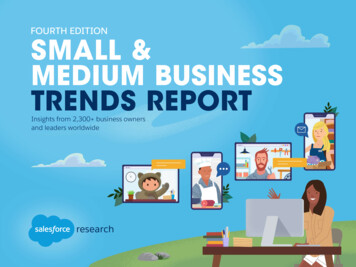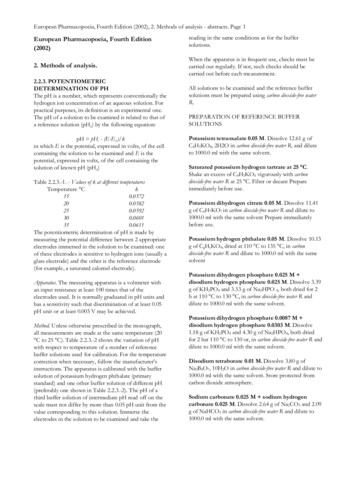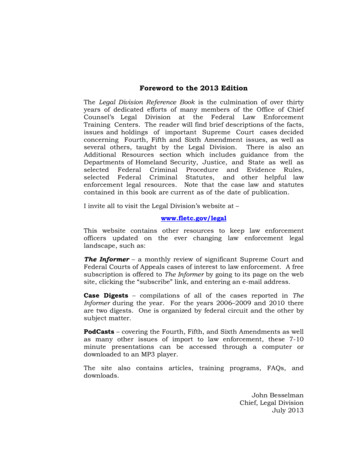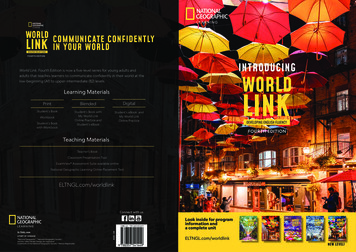
Transcription
FOU R TH EDITIONNonprofitTrendsReportNonprofit employees worldwide share theirgreatest challenges and opportunities ahead
Intro. 3About the Survey. 4Section 1: In Diversity, Equity, and Inclusion, Perceptionand Reality are Disconnected. 6Section 2: Nonprofit Staff Face Increased Challengeswith Mental Health. 8Section 3: The Workforce Is Facing a Historic Shift in HowWork Gets Done. 11ContentsSection 4: Nonprofit Fundraising and Marketing AreChanging Permanently. 18Section 5: Nonprofits Are Concerned About Expenses,Yet Outperformed in Fundraising. 28Section 6: Many Large and Mid-Sized NonprofitsExceeded Goals Despite Challenges. 29Conclusion: What’s Next for Nonprofit Professionals. 33Appendix. 34Demographics. 40
The ongoing pandemic has led to worldwide uncertainty in every sector. Lockdowns, a sudden,massive shift from in-person to virtual operations, declines in individual health and wellbeing,the urgent need for technology solutions to meet the demands of remote work — organizationshave been dealt a tough blow since spring 2020. Nonprofits were doubly challenged, acting asfirst responders to the pandemic crisis by providing aid and support to struggling communitieswhile at the same time adapting their entire operations virtually overnight.The issues that were of greatest concern for global nonprofit employees included:Introduction·······Controlling expensesAdapting to remote/virtual programsHosting in-person eventsImplementing new technology tools and solutionsHosting, creating content, and promoting virtual/online eventsRetaining volunteersChanging the size of the organization to meet increased demand for servicesThese challenges are not going away anytime soon.But there is good news: Even amid the pandemic, the nonprofit employees we surveyed saidtheir organizations managed to achieve over 75% of their goals across program delivery,fundraising, diversity initiatives, and even staff wellbeing and retention.How did they do it? Their success lies in trying new approaches to current processes, measuringsuccess and recalibrating as needed. Read on to find out how the most nimble nonprofitscontinue to thrive no matter what external circumstances come their way — through goodplanning practices, leveraging partnerships, building strong connections with employees, andcreating an organization and culture that thrive.S a les forc e.org 3
About the SurveyWe collected data from online surveys duringJune and July from nonprofit employeeswith a role of manager or higher who hadresponsibility for programs, fundraising,grants management, technology, HR/officefunctions or marketing. For details, pleasesee the Appendix.Nordics125Canada250United Kingdom250Netherlands125United States250Revenue and Size:Organizational size is categorized based onannual revenue, as follows:Small Less than 1MMedium 1M– 5MMedium — Large 5.1– 10MLarge More than 10M1,250 10nonprofit professionalsAustralia250countriesS a les forc e.org 4
Digital MaturityDigital maturity is defined as an organization's ability to leverage data to informdecision-making, reach new audiences, personalize communications, and forecastfundraising income. In order to evaluate how advanced nonprofits are when itcomes to using data for their work, we created the Digital Maturity Index in the3rd edition of the Nonprofit Trends Report, asking nonprofits to self-assess theextent to which data guides their operations. To create the Digital Maturity Index,we combined the responses to the following five areas:1. We make decisions based on data and evidence.2. When there is a problem to solve that involves different departments acrossmy organization, it is easy to find and share data.3. We design our programs and services using information about andengagement with the recipients of our programs/services.4. We are able to personalize messages to specific subgroups of our supporterswith our digital communications.5. We are able to accurately forecast income from our fundraising campaigns.Based on survey responses, we categorized organizations into three groups: lowdigital maturity, medium digital maturity, and high digital maturity. After nonprofitsrated themselves on a scale of 1 to 5 across these five questions, we createdaverage scores to categorize them. An average of less than 3.0 indicates low digitalmaturity, an average between 3.0 and 4.5 indicates medium digital maturity, andan average over 4.5 indicates high digital maturity.See page 15 for detailed findings on nonprofit digital maturity.S a les forc e.org 5
SECTION 1In Diversity, Equity, and Inclusion,Perception and Reality areDisconnectedDiversity as well as mental health and wellbeing arehot topics across all business sectors. Businesses aretackling these issues head-on — from wellbeing days toadd-on mental health services for employees; annualdiversity reports to diversity, equity, and inclusion (DEI)programs; and even employee resource groups thatprovide safe spaces for diverse groups to connect — thereare a myriad of ways that organizations are beginning tohold themselves accountable.Respondents were asked to rate the importance ofensuring gender and racial diversity across all levels ofthe organization, making sure their organization is hiringfrom across the gender spectrum as well as all racialand cultural backgrounds for all positions includingappointing a similar mix to the organization's board ofdirectors. While 87% of respondents agree that it'simportant to do so and 61% say their organizationhas made commitments to advance DEI, perceptionand reality often clash. And, the hot-button issue ofexecutive diversity is no exception.Perception:When asked where their organization stands at various levels when it comes to DEI, most respondentsrated their diversity across all stakeholders (board of directors, executives/leaders, managers, andstaff) with high marks. In fact, 80% said their organization’s board of directors was diverse.Reality:While boards might be getting slightly more diverse, they are far from representing the communitiesthey serve, according to BoardSource. Governing bodies studied by BoardSource in 2019 includeda higher percentage of people of color than the previous study (22% versus 16% in 2017). Only38% of executives felt their boards represented the communities they serve, and 66% expresseddissatisfaction with their boards’ racial and ethnic diversity. Only 29% of board chairs felt their boardsrepresented the communities they serve, and 45% expressed dissatisfaction with the boards’ racialand ethnic diversity.The good news is that 49% of nonprofits said that over the past 12 months their organization haschanged its approach to DEI and 85% said they met or exceeded their goals in this area. Some of thechanges include 37% actively increasing board diversity, 43% increasing organization/leadershipdiversity, and 35% increasing their staff diversity. And while it might not be perfect, it is a step in theright direction.** See appendix for more detail.S a les forc e.org 6
Respondents Who Rated the Following Groups Within Their Organization as Very or Somewhat DiverseOrganization's Board of DirectorsExecutives/Leaders (non-board)ManagersStaff ndsNordicsS a les forc e.org 7
SECTION 2Nonprofit Staff Face Increased Challenges withMental HealthNearly one-third (32%) of all nonprofits surveyed said ensuring the mentalhealth and wellbeing of their employees was a major issue for them over thepast year, with 38% of nonprofits with revenues of more than 10M rating it amajor issue compared to only 28% of those with revenues below 1M.* Theeven greater challenge is that 35% anticipate it will be increasingly morechallenging in the coming year. And although we have seen an influx of onlineoptions for mental health services pop up, the demand far outweighs the supply.While supporting DEI helps foster a sense of inclusion, and emotionalintelligence (EQ) can help leaders build strong working relationships whereeveryone feels valued, offering programs and services that support mental healthand overall wellbeing can help organizations to engage and retain top talent.When asked if their approach to employee wellbeing had changed during theprevious year, a slight majority of respondents (54%) acknowledged a change.The U.S. is leading the way in offering these types of services; however, variationsin government delivery of healthcare may account for some variances acrosscountries. The health system in the U.S. is much more driven by employers, whilesocialized medicine and government provisioning of healthcare services in othercountries might suppress the need for it to be offered by a nonprofit employer.* See appendix for more detail.S a les forc e.org 8
Respondents Who Say Their Organization Provides the Following ServicesGlobal %73%70%70%69%69%68%67%65%64%65%64%63% 63%62% 62%63%63%62% 61%61%60%58%55%66%65%58%61%59%58%58%54%58%58%57% 57%56%56%61%60% 60%54%57%54%54%53%53%52%52%50%49%50% 50%48%49% omoting overall/general physicalhealthMental healthresourcesCommitments toadvance diversity, equity,and inclusion (DEI)Education/trainingreimbursementStress relief/copingeducationFinancial educationWeight managementprogramsAddiction support(i.e. drug and alcoholresources for self/family)Smoking cessationprogramsS a les forc e.org 9
Mental health and wellbeing can significantlyimpact employee churn, and nonprofit staffinghas gone through a sea change at everylevel. C-suite turnover at U.S. nonprofits is atan unprecedented pace. For example, theLeadership 18 organizations — an alliance of21 CEOs leading some of America’s largestnonprofits — are undergoing dramatic changeswith more than one-third either seeking a newCEO, operating with a chief executive that hasbeen in place less than a year, or working witha boss with an interim title.Other U.S.-based research found thatemployer-provided health coverage is importantfor employee retention. According to researchby Luntz Global Partners, 56% of U.S. adultswith employer-sponsored health benefitsindicated that liking their health coverage wasa key factor in staying at their current job.Understanding what your employees need tomaintain a healthy work-life balance will beintegral to retaining top talent now and in thefuture. Seventy-six percent of respondentssaid their nonprofit offers support servicesto help with mental health and wellbeing.Offering a myriad of options that allows yourstaff to opt in to products and services thatpositively impact them and their families is asmall step towards creating the right synergiesacross the organization.S a les forc e.org 10
SECTION 3The Workforce Is Facing a Historic Shift in How WorkGets DoneRemotely managing employees andvolunteers was a major issue for one-thirdof organizations this past year. And, it'snot projected to get easier, with 84% ofrespondents saying it will remain a challengeor become increasingly more difficult over thenext 12 months. Coupled with the fact that85% of those surveyed say staff retentionwill continue to or increasingly become achallenge, organizations will need to face thisissue head on.A Harvard Business Review article found thatpeople are feeling tired and lonely at work –and its impact extends to the organizationswhere they work. The article notes that 50%of people across professions are burnedout and loneliness is actually not a result ofsocial isolation, but rather from the emotionalexhaustion of workplace burnout.Experts and companies alike struggle tocounter this growing level of burnout.Many recommendations focus on relievingstress, teaching mindfulness, and/or reducingworkload – all of which treat burnout as anindividual condition. But the links betweenburnout and loneliness suggest that greaterhuman connection may also be key to solvingthe problem.Leaders and managers can play a pivotal rolein helping employees and volunteers feel lesslonely, and therefore, less burned out. Actionslike promoting a workplace of empathy andinclusion, encouraging employees to buildnetworks that can provide emotional support,and celebrating collective success that fostersa sense of belonging are a great start.From burnout to the need to layoff or furlough workers to upgradingtechnology to meet the needs of the newdigital-first landscape, leaders are underan immense amount of pressure to keeptheir organizations afloat.S a les forc e.org 11
Staffing and Bridging the Skills Gap AreTop ChallengesAbout one-third (33%) of organizations changed theirsize based on the increased demand for services whilenearly another third (30%) changed their size based onreduced demand. It isn’t surprising then that a completeshutdown was a major concern for 32% of all respondents.Nearly one-third of nonprofits (30%) reported laying off orfurloughing staff over the past 12 months. Of those whohad to lay off or furlough staff, they reported an averageworkforce reduction of 30%. COVID-related lockdowns inthe U.S., U.K., and Australia likely spurred this spike.30%of nonprofits reportedlaying off or furloughingstaff over the past12 months33%of organizations changedtheir size based on theincreased demand forservices* See appendix for more detail.S a les forc e.org 12
U.S.U.K.Only operate/exist virtually(no longer have a physical officefor the nonprofit/charity)Regardless of whether a nonprofit had to lay offor furlough employees, the good news is thatnearly half (48%) expect to add headcount orstaff within the next 12 months (U.S.: 72%vs. Australia: 36%).* With this anticipatedincrease in headcount, nonprofit leaders needto both embrace and effectively manage thenew work-from-anywhere landscape.In the U.S. alone, 86% of respondentssaid going virtual was likely (above theglobal average of 78%). So if the office nolonger exists, it is almost certain that moreorganizations will use remote or outsourcedstaff to provide services and office functions.When asked, 79% of respondents said itwas likely their organization would outsourcejobs in the next three years.AustraliaCanadaNetherlandsNordicsOutsource jobs86%84%74%76%78%80%78%76%77%75%75%Global Average78%82%Global Average79%* See appendix for more detail.S a les forc e.org 13
U.S.U.K.AustraliaImplement widespread usage ofartificial intelligence (AI) technologyCanadaNetherlandsNordicsRely more on technology thanpeople to run the Global Average79%78%Global Average82%These unprecedented times also created aretention conundrum — 33% of nonprofits say staffretention was a major issue over the past year. Andalthough retaining staff during the pandemic wasranked lower on the list of challenges they face,40% of U.S. nonprofits rated it as a major issuecompared to 31% of nonprofits globally. Thirtyone percent are grappling with the harsh realitythat their employees' skills no longer fit the needsof their organization.* The shift to remote work andthe need to upskill employees creates an increasedreliance on technology to bridge the gap.Nonprofits may be looking to technology toautomate time-consuming manual processes thathave often plagued their ability to remain agileincluding donor management, gift processing,payroll, financial reporting, and more. And with somany struggling to retain staff, they may be lookingto upend their current staffing models. With somany struggling to retain staff, they may belooking to upend their current staffing modelsand 79% expect to implement widespreadusage of artificial intelligence (AI) technologyin the next three years.* See appendix for more detail.S a les forc e.org 14
Nonprofits Who Report Always Doing The FollowingThe questions in the chart are associated with digital maturity.Technology Is Driving Process andManagement, But Not EveryoneIs ReadyWhile technology is instrumental in shiftingto a work-from-anywhere culture, three in 10nonprofits struggle with data management acrossthe business. Only 34% reported always makingdecisions based on data and evidence as well asdesigning programs and services using informationabout and engagement with recipients. And sinceless than one-third said it was easy to find and sharedata when there is a problem involving differentdepartments, that means 69% find sharing dataacross departments to be difficult.We design our programs and servicesusing information about andengagement with the recipientsof our program/services34%We are able to personalizemessages to specific subgroupsof our supporters with our digitalcommunications34%We make decisions basedon data and evidence33%We are able to accuratelyforecast income from ourfundraising campaigns31%31%When there is a problem to solvethat invovles different departmentsacross my organization, it is easy tofind and share dataS a les forc e.org 15
Respondents Who Rated The Organization's Useof Technology In These Areas As Excellent/GoodMarketing andCommuncationsA Digital-First Shift Is Changing HowNonprofits OperateNine in 10 respondents evaluated their organization’suse of technology as excellent/good across all areas,yet only 22% fell into the high digital maturity bucket.Seventy-six percent of nonprofits said they need todevelop a data strategy for their organization andthose with a high digital maturity are 1.4x morelikely to acknowledge this compared to those witha low digital 8%Online Fundraising89%Reporting toStakeholders88%Online Fundraising89%Program Management89%0%20%40%60%80%100%S a les forc e.org 16
Bridging the digital divide has proven to be a challengefor many nonprofits, impacting their ability to forecastfundraising campaigns, a cornerstone to success. Infact, only 31% globally say they are always able toaccurately forecast income from fundraising campaigns.The comparisons are stark when you take into accountan organization's digital maturity — 64% of those witha high digital maturity are able to do so, only 24% ofthose with a medium digital maturity can, and none ofthose within the low digital maturity are able to alwaysaccurately forecast income from fundraising campaigns.Within three years, the majority of nonprofitssurveyed expect to be doing the majority of theirwork online. This potentially includes outsourcingjobs, relying on technology to run their operationsinstead of people, and fundraising 100% online.In order to accomplish this feat, their adoption oftechnology and data acumen must hasten.This monumental shift to a digital-first approachwill likely dramatically change the nonprofit sectorlandscape: testing the donor journey, evolving frompeer-to-peer and in-person events, offering donorsaccess to information on-demand. To maintain success,nonprofit leaders will need to ensure alignment acrossthe organization and create connected experiences thatmake their donors feel like they are making an impactwithout the need for face-to-face interactions.Percent of Nonprofits Who Say They're Always Able to Forecast Income by Digital Maturity0%24%64%LowDigital MaturityMediumDigital MaturityHighDigital MaturityS a les forc e.org 17
SECTION 4Fundraising and Marketing Are ChangingPermanentlyGlobally, organizations use individual donations to keep themselves afloat,with 50% of respondents attributing individual donations as a major orsignificant contributor to revenue generated over the past fiscal year. Andwhile that number varies significantly by country, it is a fact that individualdonors are the backbone of nonprofit success and need to be cultivated aswe move into a digital-first fundraising culture.But don’t expect constituents to hand over their hard-earned money withoutsomething in return. Much like an annual report shows them where theirdonation is being spent, 72% of respondents say their donors expectremote access to key impact performance metrics (KPIs) and the samepercent have plans to show real-time KPIs on their website within thenext year.S a les forc e.org 18
76%U.S.43%U.K.43%Respondents Who SaidIndividual Donations Were aMajor/Significant Contributorof RevenueAustraliaMany organizations are being more transparent,with 31% saying that over the past 12 monthsthey’ve provided existing and prospective donorsonline access to a dashboard showing impactmeasurements of their donations in action. Ofthose who have made this change, 86% say it wasimpactful. Looking at those in fundraising, 44% saythey’ve permanently added this functionality to theirfundraising approach and 15% have permanentlyreplaced their previous approach altogether.56%Netherlands50%Canada24%NordicsS a les forc e.org 19
Respondents Reporting Each Revenue Stream as a Major %35%35%32%31%30%36%35%32%While a small donation is alwaysappreciated and starts the donor’sjourney, major and planned givingare aggressively sought. U.S.nonprofits say it is their secondmajor source of funding behindindividual donations. See howeach revenue stream ranked inthe chart 0%20%20%17%15%15%15%16%14%14%12%12% 12%10%15%14%14% %16%10%8%6%7%7%7%FundraisingEventsDues forServices inProgramsMajorGiving &Planned Giving4%2%2%0%EarnedIncomeCorporateGrants ndividualDonationsMembershipDuesMajorCampaigns& Appeals(Annual/Capital)S a les forc e.org 20
Digital Channels Are the Linchpinto Future Marketing andFundraising SuccessIt is hard to separate marketing from fundraisingin the modern nonprofit world. In both cases,technology appears to be the cornerstone forsuccess. Fundraising generates considerableincome but delivery of programs impacts bothclients and the bottom line. While 36% ofrespondents said delivery of remote, virtual, andadapted programs was a major issue they’ve facedover the past year, that task seemed less dauntingat organizations with smaller revenues.The donor journey — with advocates andsupporters transitioning to receiving informationvia a preferred digital channel — could very wellbe the key in making the transition to digital-firstfundraising and marketing. Forty-two percentof respondents in marketing roles said staff attheir organizations have built or explored thedevelopment of supporter journeys throughconnected experiences between web, socialmedia, email, etc.Respondents Rating Remote, Virtual, or Adapted Program Delivery as a MajorIssue Over the Past Year by Revenue40%36%36%36% 1M – 5M 5.1M – 10M 10M30%28%20%10%0% 1MS a les forc e.org 21
Marketers at Nonprofits Who Adjusted Their Social Media StrategyOver the Past 12 Months and the Resulting ImpactAdjusted social media strategy (i.e., added new platforms like TikTok, changed content strategy)100%95%88%Additionally, 38% of those marketerssaid they adjusted their socialmedia strategy with new platformslike TikTok and changes in contentstrategy. Organizations with less than 1M in revenue embraced theseapproaches more than those withlarger revenues. Of those who madethe shift, 86% reported the change tohave been /Somewhat impactful* See appendix for more detail.S a les forc e.org 22
Marketers at Nonprofits Who Used Templates to Help with New Content CreationOver the Past 12 Months and the Resulting ImpactUsed templates to help with new content creation100%92%89%90%87%90%80%74%Marketers are also beginning to usetemplates to help with new contentcreation and of those who embracedthis change, 82% said it was traliaCanadaNetherlandsNordicsVery/Somewhat impactfulS a les forc e.org 23
Raising awareness of your nonprofit/charity100%Finding New Donors Has Become a Global ChallengeEven when pandemic restrictions relax, fundraising willcontinue to be a major challenge. According to theLilly Family School of Philanthropy at IUPUI, one out oftwo American households donated to charity in 2018compared with two out of three in 2000.Finding new donors as well as retaining existing onesis a top concern for many organizations and it startswith awareness. When asked how concerned theywere, 33% of respondents said raising awareness oftheir organization and upgrading or retaining existingdonors is a major challenge and the majority believethese issues will persist or become increasingly morechallenging over the next year.Across the board, respondents seemed to believe thateven as COVID-19 restrictions begin to ease, fundraisingchallenges will persist.As retaining donors has become more challenging,many organizations are trying new fundraisingstrategies. For some nonprofits this means a morecollaborative approach: 24% of nonprofits reportchanging their fundraising approach to partner withother nonprofits or companies, and of those, 62%say they will add this to their fundraising approachpermanently. Additionally, 28% of nonprofits shiftedfrom in-person to online events and 58% plan topermanently add or replace in-person with onlineevents as part of their fundraising approach.The Winterberry Group’s November 2020 BrandMarketer survey indicated that 81% of organizations inthe U.S and 70% in the U.K. are either currently sharingor intend to share data, showing a market that is movingfully in the direction of collaboration. Based on thefindings, researchers believe the shift in the U.K. is beingdriven by better options for collaboration and a morelimited amount of regulatory resistance.But partnerships and collaborations present even morechallenges to the modern day nonprofit — data privacylaws and honoring donors' need for privacy.86%33%Upgrading and retaining existing donors100%85%33%Percent rating as a "Major Issue"Percent rating issue as "IncreasinglyBecoming More Challenging"'S a les forc e.org 24
Organizations Must Balance Data Privacy and the OverallDonor ExperienceAs staffing changes and shifts in donor bases upended nonprofits’ statusquo, tracking donor data in a new way has become an imperative for many.Consequently, 21% of organizations started tracking donor data within one systemover the past 12 months with 89% saying the results were impactful to theirfundraising approach, ultimately leading 61% to make this a permanent additionor replacement to their current approach.And with governments around the world continuing to clamp down on howbusinesses use personal data — like the U.K.'s General with the General DataProtection Regulation (GDPR) rule, the California Consumer Privacy Act, theVirginia Consumer Data Protection Act, and China’s Personal InformationProtection Law — more nonprofits will need to ensure their processes stand upto the scrutiny.Winterberry Group recently published a white paper focused on major shifts indata-driven marketing in the U.S. and Europe during 2021 and beyond. The dataexplored ways for brands, agencies, and data providers to collaborate in the areasof sharing, protecting, activating, and monetizing privacy-compliant data assets.Challenges included the revolution against third-party cookies, increased dataprivacy regulation, and concerns about the provenance of third-party data. Thefindings suggest the path to success lies in moving the entire digital ecosystemtowards collaborative, permission-based, privacy-compliant data solutions.S a les forc e.org 25
Taking these new restrictions into account, 25% ofNonprofit Trends Report survey respondents said they’vetaken steps to restrict employee access to donor informationby donor level (i.e. only senior executives had visibilityto detailed information about major donors, etc.). Ofthose, 61% said that over the past 12 months they’vepermanently added or replaced processes to restrictemployee access to donor information by donor level.The post-cookie era is forcing a transformation on how bestto optimize revenue and deliver consistent interactionsacross channels and it is clear that the pandemic haspermanently altered fundraising forever. With face-to-facegatherings cancelled, donors moved online, requiring majorshifts for those in the nonprofit sector. Over the past 12months, 36% of respondents report they invested in newtechnology such as a CRM, collaboration/productivitytools, analytics, AI, and automation, with 87% reportingit as impactful. Of those making tech investments, 60%reported making permanent adjustments to fundraisingrelated to investing in these new technologies.Thirty-three percent of respondents felt the onlinefundraising and payment experience was a major issue.As such, 24% of organizations added recurring donationoptions — such as direct withdrawal or automated reminderswith one-button donation authorization — to their fundraisingapproach over the past 12 months. Twenty six percentadded more payment methods such as Venmo, PayPal,Apple Pay, and cryptocurrencies, with the majority sayingthey were impactful.Nonprofits Who Added the Following Donor Options Over the
first responders to the pandemic crisis by providing aid and support to struggling communities . While boards might be getting slightly more diverse, they are far from representing the communities . socialized medicine an











